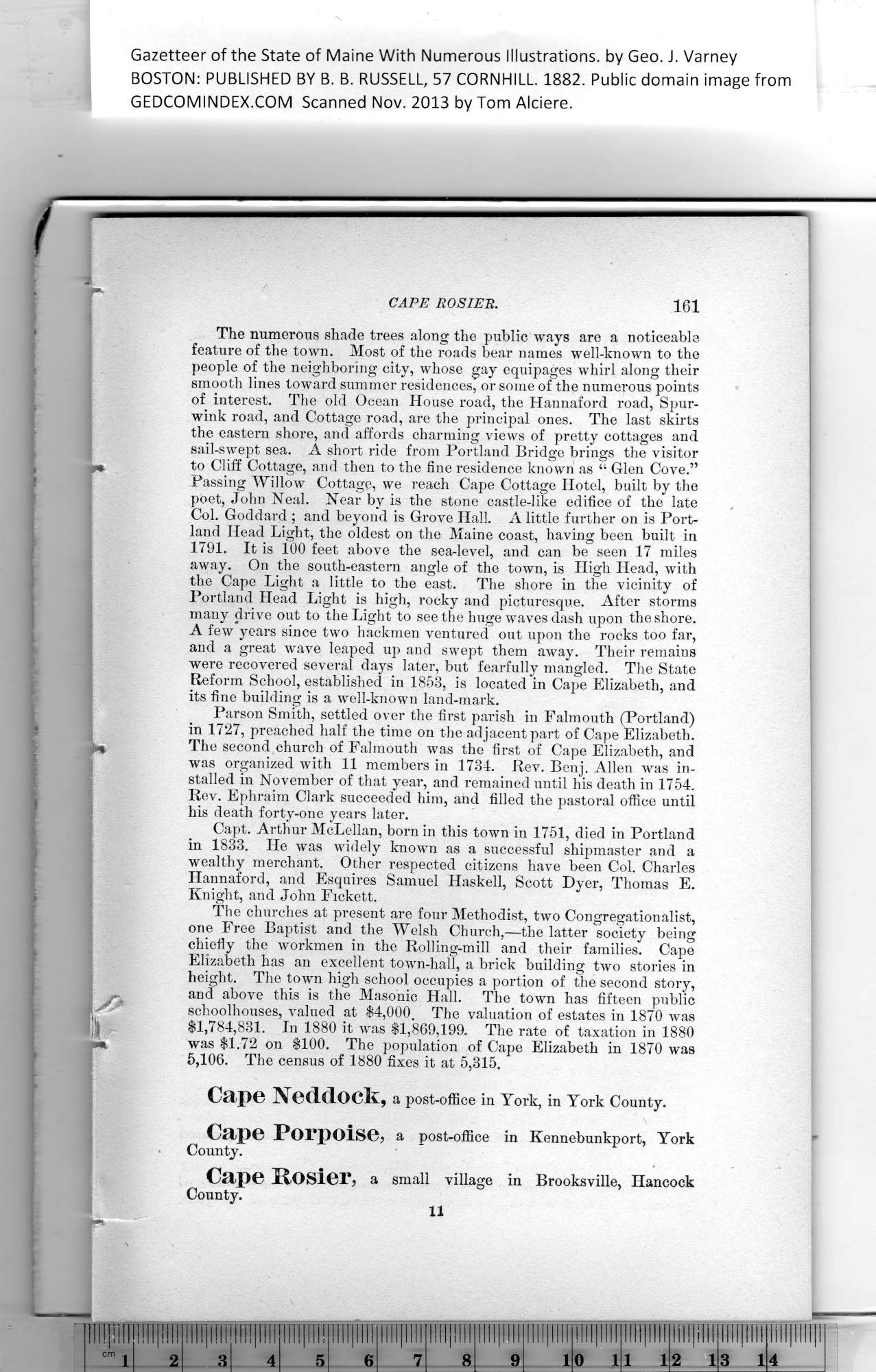|
Gazetteer of the State of Maine With Numerous Illustrations, by Geo. J. Varney
BOSTON: PUBLISHED BY B. B. RUSSELL, 57 CORNHILL. 1882. Public domain image from
CAPE ROSIER. 161
The numerous shade trees along the public ways are a noticeable
feature of the town. Most of the roads bear names well-known to the
people of the neighboring city, whose gay equipages whirl along their
smooth lines toward summer residences, or some of the numerous points
of interest. The old Ocean House road, the Hannaford road, Spur-
wink road, and Cottage road, are the principal ones. The last skirts
the eastern shore, and affords charming views of pretty cottages and
sail-swept sea. A short ride from Portland Bridge brings the visitor
to Cliff Cottage, and then to the fine residence known as “ Glen Cove.”
Passing Willow Cottage, we reach Cape Cottage Hotel, built by the
poet, John Neal. Near by is the stone eastle-like edifice of the late
Col. Goddard ; and beyond is Grove Hall. A little further on is Port-
land Head Light, the oldest on the Maine coast, having been built in
1791. It is 100 feet above the sea-level, and can be seen 17 miles
away. On the south-eastern angle of the town, is High Head, with
the Cape Light a little to the east. The shore in the vicinity of
Portland Head Light is high, rocky and picturesque. After storms
many drive out to the Light to see the huge waves dash upon the shore.
A few years since two hackmen ventured out upon the rocks too far,
and a great wave leaped up and swept them away. Their remains
were recovered several days later, but fearfully mangled. The State
Reform School, established in 1853, is located in Cape Elizabeth, and
its fine building is a well-known land-mark.
Parson Smith, settled over the first parish in Falmouth (Portland)
i in 1727, preached half the time on tbe adjacent part of Cape Elizabeth.
The second church of Falmouth was the first of Cape Elizabeth, and
was organized with 11 members in 1734. Rev. Benj. Allen was in-
stalled in November of that year, and remained until his death in 1754.
Rev. Ephraim Clark succeeded him, and filled the pastoral office until
bis death forty-one years later.
Capt. Arthur McLellan, born in this town in 1751, died in Portland
in 1833. He was widely known as a successful shipmaster and a
wealthy merchant. Other respected citizens have been Col. Charles
Hannaford, and Esquires Samuel Haskell, Scott Dyer, Thomas E.
Knight, and John Fickett.
The churches at present are four Methodist, two Congregationalist,
one Free Baptist and the Welsh Church,—the latter society being
chiefly the workmen in the Rolling-mill and their families. Cape
Elizabeth has an excellent town-hall, a brick building two stories in
height. The town high school occupies a portion of the second story,
and above this is the Masonic Hall. The town has fifteen public
schoolhouses, valued at $4,000. The valuation of estates in 1870 was
$1,784,831. In 1880 it was $1,869,199. The rate of taxation in 1880
was $1.72 on $100. Tbe population of Cape Elizabeth in 1870 was
5,106. The census of 1880 fixes it at 5,315.
Cape Neddock, a post-office in York, in York County.
Cape Porpoise, a post-office in Kennebunkport, York
County.
Cape Rosier, a small village in Brooksville, Hancock
County.
PREVIOUS PAGE ... NEXT PAGE
This page was written in HTML using a program written in Python 3.2
|
